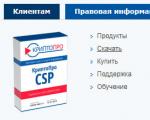Recovery general usb flash disk. Controller flashing. Determining the controller type
Transcend's removable drives are used by a very large number of users around the world. No wonder, because these flash drives are quite inexpensive, and serve for a long time. But sometimes some kind of misfortune happens to them - the information disappears due to damage to the drive.
This may happen according to different reasons. Some flash drives fail due to the fact that someone dropped them, others simply because they are already old. In any case, every user who has a removable media from Transcend should know how to recover data on it if they are lost.
There are proprietary utilities that allow you to very quickly recover data from Transcend USB drives. But there are programs that are designed for all flash drives, but they work especially well with Transcend products. In addition, often in working with flash drives of this company helps standard way Windows data recovery.
Method 1: RecoveRx
This utility allows you to recover data from flash drives and protect them with a password. It also allows you to format drives from Transcend. Suitable for absolutely all removable media from Transcend and is proprietary software for this product. To use RecoveRx for data recovery, follow these steps:


Method 2: JetFlash Online Recovery
This is another proprietary utility from Transcend. Its use looks very simple.

Method 3: JetDrive Toolbox
Interestingly, the developers position this tool as software for Apple computers, but it also works very well on Windows. To restore using JetDrive Toolbox, follow these steps:

JetDrive Toolbox actually works exactly the same as RecoveRx. The difference is that there are a lot more tools here.
Method 4: Transcend Autoformat
If none of the above standard recovery utilities help, you can use Transcend Autoformat. True, in this case, the flash drive will be formatted immediately, that is, there will be no chance to extract any data from it. But it will be restored and ready to go.
Using Transcend Autoformat is extremely simple.
- and run it.
- At the top, select the letter of your storage medium. Below, indicate its type - SD, MMC or CF (just check the box next to the desired type).
- Click on the button " Format" to start the formatting process.

Method 5: D-Soft Flash Doctor
This program is famous for the fact that it works at a low level. Based on user feedback, flash drives Transcend she is very efficient. Removable media repair using D-Soft Flash Doctor is performed as follows:

If repair using all the above methods does not help restore the media, you can use standard tool Windows recovery.
Method 6: Windows Recovery Tool

Judging by the reviews, these 6 methods are the most optimal in the case of a damaged Transcend flash drive. Less efficient in this case is the EzRecover program. How to use it, read the review on our website. You can also use D-Soft Flash Doctor and JetFlash Recovery Tool. If none of these methods help, it's best to just buy a new removable media and use it.
There are many factors that lead to the fact that flash drives refuse to work. In this article, we will consider not the reasons, but ways to return products to full functioning. To do this, we will study the process of how to flash a USB flash drive using special utilities.
Function not available USB formatting drive, operating system software signals errors, and special utilities do not give the desired result? You can restore the functioning of the product by flashing a flash drive, or rather, flashing a flash drive controller.
Firmware is usually called firmware, which consists of service information on microcircuits and controller microcode. This microcode is embedded in the product during the manufacture of the gadget at the factory. The service can overwrite many times during operation.
Performing a software repair (repeating the factory steps) consists of the following:
- Cleaning.
- Memory testing.
- The process of compiling new translation tables, their subsequent recording in the service fields.
All of the above actions are "low-level formatting".
For similar works utilities for controller models have a strict specialization. Because of this, the repairman needs to find the appropriate one for a particular instance. Chip options may vary in different batches. In some cases, you have to sort through more than a dozen options.
Definition of type (brand)
Before the flash drive is flashed, it is required to determine the PID, VID values for it. With their help, you can find out the model by which the technological program for repair will be determined. To determine the model, the easiest way is to look at the marking after opening the case. A more gentle way is to use software methods.
Special software is used that recognizes any USB flash drive to find the manufacturer's identifier (VID code) and product identifier (PID code). For example, let's take the Flash Drive Information Extractor program (there are many other software).
After the application installation process, run the GetFlashInfo.exe file. Then we click on "Get data" and the user will be presented with a report with the codes of interest.
Based on the received VID and PID data, we determine the controller and software (UTILS) in the iFlash database so that the flash drive controller is flashed.
With a similar controller, other devices will be presented in the list. Of these, more similar ones are intuitively selected. Now you need to find the utility, enter the found name in the search engine. If the resource you are looking for is not found, you can turn to other sources or google. If the name is slightly different, everything should work out.
Choosing an operating system for technoutilities
Best of all, technological utilities work under Windows XP. Manufacturers are more conservative and do not chase after fashion. In the work it is necessary to install drivers and perform other "dangerous" actions. Therefore, you need to have administrator rights.
How to flash a flash drive found program?
First, turn off the drive, and then run the exe file of the downloaded and unpacked software (in our example, MPTool.exe).
Search in the archive text file readmi.txt (read me). It may contain useful data, an instruction, or a link to a source with it. Google translate can translate English text.
When the application is launched, we connect the USB flash drive to the PC. Information about it will be shown in the program window. After pressing the "Start" button, the process of flashing the flash drive will begin, which is reflected in the yellow bar.
When the flashing is completed, an approving text will be displayed on a green background in one of the cells - OK.
Immediately the operating system will be prompted to format the disk. If the computer has correct driver, then everything can work out. If the driver is missing, then you need to detach / attach the drive. Then the necessary driver will be installed automatically, the flash drive will be displayed in the explorer, after which you can start formatting.
With other utilities, the actions may differ, but not so critical that the user cannot cope with the process.
IN general access manufacturers began to add software, which is intended for repairing flash drives. To download what is necessary in a particular situation, select a model in the technical support section. Sometimes you may need additional serial number. Quite often, the serial number is requested by the program itself and checked using the Internet. It will not be superfluous to authenticate using the SerialCheck software, since fakes are all around us.
For almost all models, you can restore functionality by using proprietary software. It is possible to find similar situations on the forums. The process of flashing the controller of the Chinese flash drive has no differences, except for its smaller capacity compared to the declared one. A flash drive can be unrepairable if the brand of the controller is unrecognized.
SanDisk flash drives are in difficult situations. This is due to the conduct of their corporate policy. The company itself performs a full production cycle, starting with the development of non-standard solutions and ending with implementation. There is no repair software for them.
There are several solutions for backing up data:
- Embedded in operating system applications. Microsoft Windows provides ways Reserve copy data that involves saving files and data on external or built-in storage media. All modern Windows versions already include the ability to create backup necessary files or all hard drive, if necessary. Provided Windows features are complete and independent, and are aimed at ensuring that you do not need to use third-party services or programs.
- Copying data manually. You can always use the old proven way to back up data - manually copying data to an external storage medium. This is long, but if you work with a small amount of data, this solution may be quite acceptable for you.
- Online services. Recently, the most modern way of backing up data has become increasingly popular - these are numerous online services. Companies that provide online backup of your files. A small background application installed on the computer creates copies of the necessary data and saves them on a remote server. However, the volumes provided by such companies for storing your files in free version do not allow them to be used as a complex solution. Often the space offered for backing up data does not exceed 10 GB, so there is no need to talk about creating a backup copy of the entire hard drive. Such services are rather aimed at backing up a separate number of files.
- Create a disk image. This is the most complete data backup solution for advanced users. This method involves the use third party program to create an image of the entire disk, which can be deployed if necessary on another storage medium. By using this decision, you can in a short period of time get access to all the data that was on the disk at the time of its backup: documents, programs and media files.
Mirex flash drive models for 64gb, 32gb, 16gb, 8gb, 4gb, 2 gb:
- ARTON;
- BINAR;
- KNIGHT;
- RABBIT;
- ROCKET DARK;
- DRAGON;
- HARBOR;
- CHROMATIC;
- TURNING KNIFE;
- crab;
Many factors lead to the “diseases” of flash drives (when they refuse to work). In this publication, we will not be interested in them (reasons), but in ways to return gadgets to full functioning - how to flash or reflash a flash drive.
It is not difficult to flash or flash a flash drive.
The main purpose of using a flash drive is to write data. Data (together with a flash drive) has a wide variety of purposes - from simple storage to OS boot (even fingerprint verification).
Architecture and recording system
It is also important for the topic of our article to understand its constituent components:
- The physical connection to the PC is made using the USB interface (sometimes it is microUSB);
- Controller;
- Memory chip;
- USB signal oscillator.
For recording used (depending on size) FAT system(16, 32 or ex). For capacities over 64 GB, exFAT or NTFS. If using the gadget becomes problematic (read-write errors) - it needs to be formatted or reflashed.
Windows tools

Flashing a flash drive
If formatting the drive is not available (the OS program reports errors and special utilities do not work), then to bring it back to life, you will need a flash drive firmware, or rather, a flash drive controller firmware.
The correct name for what is commonly called firmware is firmware, which consists of controller microcode and service data on microcircuits. The microcode is embedded in the device during manufacture at the factory. But the service is often rewritten during operation.
Software repair (repeating factory actions) includes clearing, testing memory, compiling new translation tables and writing them into service fields - this is exactly what “low-level formatting” is.
Utilities for such work have a strict specialization in controller models. Therefore, the repairman needs to find one that corresponds to a specific instance (after all, microcircuit options can change from batch to batch!) - patiently sorting through even more than a dozen.
We define the brand (type)
Before flashing a USB flash drive, you need to determine the values \u200b\u200bof VID, PID for it. From them we will recognize the model, and from it we will find technological software for repair. To determine the model, it would be easiest to look at the marking after opening the case. It will be more gentle to use software methods.
Special software is used to find the VID (identifying manufacturer) and PID (for product identification) codes that recognize any USB flash drive. For one of the devices it will help us (for example) Flash program Drive Information Extractor (there are many others).
After installing the application and running the GetFlashInfo.exe file, click "Get Data". Let's get an example report:

Based on the obtained values for VID and PID, substituted in the database window, the controller and the program (UTILS) for flashing the flash drive are determined:

With the same controller, there will be other devices in the list. Of these, the more similar one is selected (intuitively). Now we find the utility - in the search we drive in the found name. If what you are looking for is not found on this site, then you can google it or turn to other sources. Even if the name is slightly different - it's okay - it should work.
Choosing an OS for technoutilities
Technological utilities work better under Windows XP - production workers are more conservative and not chasing fashion. In addition, due to the fact that it will require the installation of drivers and other "dangerous" actions, you need to have administrator rights.
We reflash the found program
We turn off the drive, run the executable exe file of the downloaded and unpacked utility (in this case, MPTool.exe).
IMPORTANT. It is worth looking in the archive for a text file "read me" (readme.txt) - it may contain useful information. It may contain an instruction or a hyperlink to a source with it. English text translate with google translator.
After launching the application, we connect the USB flash drive to the PC - information about it appears in the program window. By pressing the "Start" key, the flashing starts. The process is indicated by a yellow bar.

At the end - an encouraging text will be displayed on the green background of one of the cells - OK.

The OS immediately prompts you to format the disk. If you have the right driver installed, then everything will work out. If not, then you need to disconnect / attach the gadget. Then the driver will be installed automatically and the flash drive will appear in the explorer - you can format it.
With another utility, the actions may be slightly different, but not so critical that it cannot be dealt with.
Manufacturers began to share software for repairing flash drives. To download what you need in a particular case - in the technical support section, the model (sometimes additionally the serial number) is indicated. In some cases, the serial number is requested by the software itself (with verification via the Internet). SerialCheck authentication will not be superfluous, since fakes surround us everywhere.
Almost any model can be revived with the help of proprietary programs. Plus the ability to find a similar case on the forums. The firmware of the controller of the Chinese flash drive is no different, except for their smaller capacity compared to the declared one. A flash drive with an unidentified controller brand can be non-repairable.
Difficult cases include SanDisk flash drives. It has to do with corporate policy. The company itself carries out a full production cycle - from the development of non-standard solutions to sales. There is no repair software for them. If you can’t find the utility, don’t worry and use the bucket.
Flash drive prevention
As we have already understood, it is better not to bring the flash drive to the point of need for repair. Here are some recommendations to minimize unwanted effects:
- Protection from temperature fluctuations, from the influence of water, aggressive environments, mechanical influences, X-rays, electromagnetic fields. Accuracy of insertion/extraction;
- Filling the flash drive "to the eyeballs" of it file system may be damaged. A dangerous symptom when recording is slowing down and freezing;
- Check the flash drive using OS tools, do defragmentation;
- Do not use a flash drive as the only copy of data (imagine that you have only one apartment key);
- Follow the procedure for safely removing the flash drive;
- To avoid static discharges, do not touch the contacts of the flash drive with your fingers, metal objects, avoid contact with other synthetics;
- If the flash drive behaves strangely, do not rush to treat it with low-level programs. First, copy important files to another media, and then start repairing.
Now you know how to flash a USB flash drive and you can figure it out on your own. May your flash drives live long.
Leave your comments.




